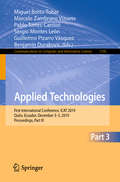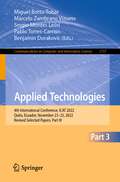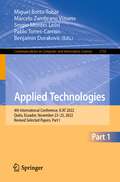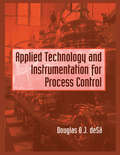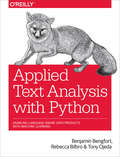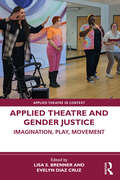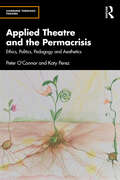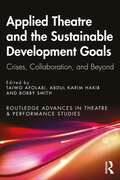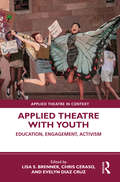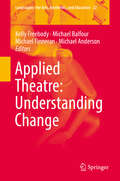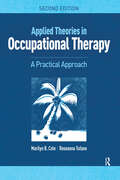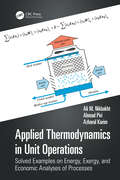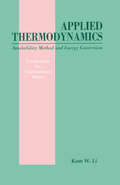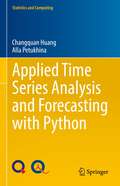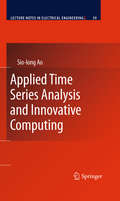- Table View
- List View
Applied Technologies: First International Conference, ICAT 2019, Quito, Ecuador, December 3–5, 2019, Proceedings, Part III (Communications in Computer and Information Science #1195)
by Miguel Botto-Tobar Marcelo Zambrano Vizuete Pablo Torres-Carrión Sergio Montes León Guillermo Pizarro Vásquez Benjamin DurakovicThis thirs volume of the three-volume set (CCIS 1193, 1194, 1195) constitutes the refereed proceedings of the First International Conference on Applied Technologies, ICAT 2019, held in Quito, Ecuador, in December 2019. The 124 full papers were carefully reviewed and selected from 328 submissions. The papers are organized according to the following topics: technology trends; computing; intelligent systems; machine vision; security; communication; electronics; e-learning; e-government; e-participation.
Applied Technologies: Second International Conference, ICAT 2020, Quito, Ecuador, December 2–4, 2020, Proceedings (Communications in Computer and Information Science #1388)
by Miguel Botto-Tobar Marcelo Zambrano Vizuete Pablo Torres-Carrión Sergio Montes León Oscar Camacho Danilo ChávezThis volume constitutes the refereed proceedings of the Second International Conference on Applied Technologies, ICAT 2020, held in Quito, Ecuador, in December 2020. Due to the COVID-19 pandemic the conference was held online. The 53 papers were carefully reviewed and selected from 145 submissions. The papers are organized according to the following topics: communication; computing; e-government and e-participation; e-learning; electronics; intelligent systems; machine vision; security; technology trends.
Applied Technologies: Third International Conference, ICAT 2021, Quito, Ecuador, October 27–29, 2021, Proceedings (Communications in Computer and Information Science #1535)
by Miguel Botto-Tobar Marcelo Zambrano Vizuete Pablo Torres-Carrión Sergio Montes León Benjamin DurakovicThis volume constitutes the refereed proceedings of the Third International Conference on Applied Technologies, ICAT 2021, held in Quito, Ecuador, in October 2021. The 40 papers were carefully reviewed and selected from 201 submissions. The papers are organized according to the following topics: communication; computing; e-government and e-participation; e-learning; electronics; general track; intelligent systems; machine vision; security; technology trends.
Applied Technologies: Third International Conference, Icat 2021, Quito, Ecuador, October 27-29, 2021, Proceedings (Communications In Computer And Information Science Series #1535)
by Miguel Botto-Tobar Marcelo Zambrano Vizuete Pablo Torres-Carrión Sergio Montes León Benjamin Durakovic<p>This volume constitutes the refereed proceedings of the Third International Conference on Applied Technologies, ICAT 2021, held in Quito, Ecuador, in October 2021.<p> <p>The 40 papers were carefully reviewed and selected from 201 submissions. The papers are organized according to the following topics: communication; computing; e-government and e-participation; e-learning; electronics; general track; intelligent systems; machine vision; security; technology trends.<p>
Applied Technologies: Third International Conference, Icat 2021, Quito, Ecuador, October 27-29, 2021, Proceedings (Communications In Computer And Information Science Series #1535)
by Miguel Botto-Tobar Marcelo Zambrano Vizuete Pablo Torres-Carrión Sergio Montes León Benjamin Durakovic<p>This volume constitutes the refereed proceedings of the Third International Conference on Applied Technologies, ICAT 2021, held in Quito, Ecuador, in October 2021.<p> <p>The 40 papers were carefully reviewed and selected from 201 submissions. The papers are organized according to the following topics: communication; computing; e-government and e-participation; e-learning; electronics; general track; intelligent systems; machine vision; security; technology trends.<p>
Applied Technology and Instrumentation for Process Control
by Douglas O. de SaApplied Technology and Instrumentation for Process Control presents the complex technologies of different manufacturing processes and the control instrumentation used. The large variety of processes prohibits covering more than a few. Carefully selected and diverse, but representative, examples show how fundamentally basic simpler elements or techn
Applied Text Analysis with Python: Enabling Language-Aware Data Products with Machine Learning
by Tony Ojeda Benjamin Bengfort Rebecca BilbroFrom news and speeches to informal chatter on social media, natural language is one of the richest and most underutilized sources of data. Not only does it come in a constant stream, always changing and adapting in context; it also contains information that is not conveyed by traditional data sources. The key to unlocking natural language is through the creative application of text analytics. This practical book presents a data scientist’s approach to building language-aware products with applied machine learning.You’ll learn robust, repeatable, and scalable techniques for text analysis with Python, including contextual and linguistic feature engineering, vectorization, classification, topic modeling, entity resolution, graph analysis, and visual steering. By the end of the book, you’ll be equipped with practical methods to solve any number of complex real-world problems.Preprocess and vectorize text into high-dimensional feature representationsPerform document classification and topic modelingSteer the model selection process with visual diagnosticsExtract key phrases, named entities, and graph structures to reason about data in textBuild a dialog framework to enable chatbots and language-driven interactionUse Spark to scale processing power and neural networks to scale model complexity
Applied Theatre and Gender Justice: Imagination, Play, Movement (Applied Theatre in Context)
by Lisa S. Brenner Evelyn Diaz CruzApplied Theatre and Gender Justice is a collection of essays highlighting the value and efficacy of using applied theatre to address gender in a broad range of settings, identifying challenges, and offering concrete best practices.This book amplifies and shares lessons from practitioners and scholars who use performance to create models of collective solidarity, building upon communities’ strengths toward advocating for justice and equity. The book is divided into thematic sections, comprising three essays addressing a range of questions about the challenges, learning opportunities, and benefits of applied theatre practices. Further exploring the themes, issues, and ideas, each section ends with a moderated roundtable discussion between the essays' authors.Part of the series Applied Theatre in Context, Applied Theatre and Gender Justice, this book is an accessible and valuable resource for theatre practitioners and the growing number of theatre companies with education and community engagement programs. Additionally, it provides essential reading for teachers and students in a myriad of fields: education, theatre, civic engagement, criminal justice, sociology, women and gender studies, environmental studies, disability studies, and ethnicity and race studies.
Applied Theatre and Intercultural Dialogue: Playfully Approaching Difference (Palgrave Studies In Play, Performance, Learning, and Development)
by Elliot LefflerThis book examines applied theatre projects that bring together diverse groups and foster intercultural dialogue. Based on five case studies and informed by play theory, it argues that the playful elements of theatre processes nurture a unique intimacy among diverse people. However, this playful quality can also dampen explicit conversations about participants’ cultural differences, and defer an interrogation of people’s own entrenchment in systemic power imbalances. As a result, addressing these differences and imbalances in applied theatre contexts may require particular strategies.
Applied Theatre and Sexual Health Communication: Apertures of Possibility (Contemporary Performance InterActions)
by Katharine E. LowThis book analyses the partnership between applied theatre and sexual health communication in a theatre-making project in Nyanga, a township in South Africa. By examining the bridges and schisms between the two fields as they come together in the project, an alternative way of approaching sexual health communication is advocated. This alternative considers what it is that applied theatre does, and could become, in this context. Moments of value which lie around the margins of the practice emerge as opportunities that can be overlooked. These somewhat ephemeral, intangible moments, which appear on the edges, are described as ‘apertures of possibility’ and occur when one takes a step back and realises something unnoticed in the moment. This book offers an invitation to pause and notice the seemingly insignificant moments that often occurs tangentially to the practice. The book also calls for more outcry about sexual health and sexual violence, arguing for theatre-making as a route to multitudes of voices, nuanced understandings, and diverse spaces in which discussions of sexuality and sexual health are shared, felt, and experienced.
Applied Theatre and the Permacrisis: Ethics, Politics, Pedagogy and Aesthetics (Learning Through Theatre)
by Peter O'Connor Katy PérezResponding to the global state of permacrisis, this book explores the relationship between applied theatre and disaster.For millennia communities have learnt to live alongside disaster through their arts making. Building on the basis of this ancestral knowledge this book explores the current uses of applied theatre in times of constant crisis. Using a critical disaster studies lens, the authors recognise the role of governments and multinational businesses in profiteering from and manipulating for their own advantage the misery caused by disasters. Case studies of different stages of disaster, from risk reduction and disaster preparedness through to the almost inevitable resistance to failed government intervention, illustrate the possibilities and limitations of applied theatre and other art forms to navigate these times. Applied theatre is seen as a vital act of aesthetic and political hope.At a time of never-ending, overlapping disasters, this book will be important to researchers and postgraduate students working in applied theatre and disaster research in the social sciences. It will also appeal to applied arts practitioners who work in disaster zones and with relief organisations.
Applied Theatre and the Sustainable Development Goals: Crises, Collaboration, and Beyond (ISSN)
by Bobby Smith Taiwo Afolabi Abdul Karim HakibThis book is the first definitive publication to consider the intersections of applied theatre and the Sustainable Development Goals (SDGs) – a series of goals which have shaped development and social justice initiatives from 2015 to 2030.It brings together emerging and leading scholars and practitioners engaged in creative and community contexts globally. In so doing, the book offers critical insights to explore the convergences, complexities, and tensions of working within development frameworks, through theatre. Divided into three thematic areas, it maps out the ways in which applied theatre has related to the SDGs, examines issues with global collaborations, and, as 2030 approaches and the SDG era draws to a close, interrogates such practices, envisioning what the role of applied theatre might be in the post-SDG era. The book provokes reflection about this specific era of applied theatre and global development, as well as discussion regarding what comes next.This volume will be of importance to students, artists, scholars, practitioners, and policymakers working in applied theatre and the field of development.
Applied Theatre in Paediatrics: Stories, Children and Synergies of Emotions (Learning Through Theatre)
by Persephone SextouThis book explores applied theatre practice for children in environments of illness and cure and how it can powerfully normalise children’s hospitalisation experience. It is an essential tool for making meaning of children’s illness, putting it into a fictional context and developing better control of their clinical experiences. It can be central to raising the standards of care and quality of life during illness. Taken from the author’s research and participatory bedside theatre practice in hospitals before, during and after the COVID-19 pandemic, this book demonstrates new learning about aesthetics, ethics, emotions, stories, puppetry, digital arts and research methodologies about children’s health and wellbeing. It provides a selection of ten unique stories told by children inspired by applied theatre practice in paediatrics, cardiac, oncology, neurosurgery, burns units and complex and intensive care wards. Stories aid in understanding the language of children’s pain for a better assessment and management of pain by healthcare professionals through the arts. It analyses synergistic theatre performance in 'stitched lands' between challenging realities and safe fictionalities. This book enables artists to develop new ways of thinking and contributes to further improvements in the provision of education and reflective learning in the field. It also addresses the emotional labour of the artist in healthcare and makes recommendations for balanced training to prevent emotional exhaustion. Designed for artists, healthcare professionals, therapists, play specialists and teachers who work with children in healthcare, this text aims to help many people find creative ways of making a positive difference in sick children’s lives. It is a book for those who love and care for children.
Applied Theatre with Youth: Education, Engagement, Activism (Applied Theatre in Context)
by Lisa S. Brenner, Chris Ceraso, and Evelyn Diaz CruzApplied Theatre with Youth is a collection of essays that highlight the value and efficacy of applied theatre with young people in a broad range of settings, addressing challenges and offering concrete solutions. This book tackles the vital issues of our time—including, among others, racism, climate crisis, gun violence, immigration, and gender—fostering dialogue, promoting education, and inciting social change. The book is divided into thematic sections, each opening with an essay addressing a range of questions about the benefits, challenges, and learning opportunities of a particular type of applied theatre. These are followed by response essays from theatre practitioners, discussing how their own approach aligns with and/or diverges from that of the initial essay. Each section then ends with a moderated roundtable discussion between the essays’ authors, further exploring the themes, issues, and ideas that they have introduced. With its accessible format and clear language, Applied Theatre with Youth is a valuable resource for theatre practitioners and the growing number of theatre companies with education and community engagement programs. Additionally, it provides essential reading for teachers and students in a myriad of fields: education, theatre, civic engagement, criminal justice, sociology, women and gender studies, environmental studies, disability studies, ethnicity and race studies.
Applied Theatre: The Key Concepts (Routledge Key Guides)
by Kay HepplewhiteThis accessible book outlines the key ideas that define the global phenomenon of applied theatre, not only its theoretical underpinning, its origins and practice, but also providing eight real-life examples drawn from a diversity of forms and settings.The clearly arranged topic sections entitled When, What, Who, Why and Where emphasise the responsive nature of applied theatre, its social context and the importance of a beneficial outcome for participants, which can connect fields as disparate as health, criminal justice, education and migration. Labels and terms are explained, along with applied theatre’s core values, motivations and objectives, allowing the reader to build a coherent understanding of its distinguishing features.Applied Theatre: The Key Concepts is aimed at students, academics, artists and practitioners of applied theatre as well as those with an interest in this vital blend of social and creative practice.
Applied Theatre: Understanding Change (Landscapes: the Arts, Aesthetics, and Education #22)
by Michael Anderson Kelly Freebody Michael Balfour Michael FinneranThis volume offers researchers and practitioners new perspectives on applied theatre work, exploring the relationship between applied theatre and its intent, success and value. Applied theatre is a well-established field focused on the social application of the arts in a range of contexts including schools, prisons, residential aged care and community settings. The increased uptake of applied theatre in these contexts requires increased analysis and understanding of indications of success and value. This volume provides critical commentary and questions regarding issues associated with developing, delivering and evaluating applied theatre programs. Part 1 of the volume presents a discussion of the ways the concept of change is presented to and by funding bodies, practitioners, participants, researchers and policy makers to discover and analyse the relationships between applied theatre practice, transformative intent, and evaluation. Part 2 of the volume offers perspectives from key authors in the field which extend and contextualize the discussion by examining key themes and practice-based examples.
Applied Theories in Occupational Therapy: A Practical Approach
by Marilyn B. Cole Roseanna TufanoApplied Theories in Occupational Therapy: A Practical Approach provides a comprehensive overview of theories and frames of reference in occupational therapy.
Applied Theories in Occupational Therapy: A Practical Approach
by Marilyn B. Cole Roseanna TufanoApplied Theories in Occupational Therapy: A Practical Approach, Second Edition provides a system-based, comprehensive overview of the theories, models, and frames of reference that influence occupational therapy around the world. Esteemed authors Marilyn B. Cole and Roseanna Tufano have updated their foundational text with an evidence-based focus derived from their experiences of more than 30 years teaching theoretical content to students. <P><P> Applied Theories in Occupational Therapy: A Practical Approach, Second Edition offers practical templates to help readers learn the key constructs of each theory and assimilate knowledge based on Mosey’s organizational structure. Each theory-based chapter is designed for ease in gathering content knowledge and comparing theories in a distinctive manner. The book includes: Summaries of the current trends found in practice, along with external influential models of health and wellness impacting populations of concern Exploration of some of the most common occupation-based models around the world. Each model’s holistic conceptual nature is described, including theoretical assumptions and practice guidelines for evaluation and intervention Reviews of common frames of reference found in evidence-based practice, which address the secondary and tertiary needs of common populations In this Edition, learning activities and case-based analyses strengthen the application of theory into current practice contexts. Practical guidelines assist the reader in formulating an evaluation process and determining the relevant intervention strategies that promote occupational participation, engagement, and functioning across the lifespan and the continuum of health. Instructors in educational settings can visit www.efacultylounge.com for additional education material to be used for teaching in the classroom.
Applied Theories in Occupational Therapy: A Practical Approach
by Marilyn B. Cole Roseanna TufanoApplied Theories in Occupational Therapy: A Practical Approach, Second Edition provides a system-based, comprehensive overview of the theories, models, and frames of reference that influence occupational therapy around the world. Esteemed authors Marilyn B. Cole and Roseanna Tufano have updated their foundational text with an evidence-based focus derived from their experiences of more than 30 years teaching theoretical content to students. Applied Theories in Occupational Therapy: A Practical Approach, Second Edition offers practical templates to help readers learn the key constructs of each theory and assimilate knowledge based on Mosey’s organizational structure. Each theory-based chapter is designed for ease in gathering content knowledge and comparing theories in a distinctive manner. The book includes: Summaries of the current trends found in practice, along with external influential models of health and wellness impacting populations of concern Exploration of some of the most common occupation-based models around the world. Each model’s holistic conceptual nature is described, including theoretical assumptions and practice guidelines for evaluation and intervention Reviews of common frames of reference found in evidence-based practice, which address the secondary and tertiary needs of common populations In this Edition, learning activities and case-based analyses strengthen the application of theory into current practice contexts. Practical guidelines assist the reader in formulating an evaluation process and determining the relevant intervention strategies that promote occupational participation, engagement, and functioning across the lifespan and the continuum of health.Included with the text are online supplemental materials for faculty use in the classroom.
Applied Therapeutics: The Clinical Use Of Drugs
by Caroline S. Zeind Michael G. CarvalhoContinually revised and updated for over 40 years, Applied Therapeutics: The Clinical Use of Drugsis the gold standard for patient-centered drug therapeutics.
Applied Thermodynamics for Meteorologists
by Miller SamThis textbook on atmospheric thermodynamics is for students of meteorology or atmospheric science. It also serves as a reference text for working professionals in meteorology and weather forecasting. It is unique because it provides complete, calculus-based derivations of basic physics from first principles, and connects mathematical relationships to real-world, practical weather forecasting applications. Worked examples and practice problems are included throughout.
Applied Thermodynamics in Unit Operations: Solved Examples on Energy, Exergy, and Economic Analyses of Processes
by Azharul Karim Ali M. Nikbakht Ahmad PiriThe growing demand of energy accounting in industries is the main challenge for academics and engineers working in chemical processing plants, food industries, and the energy sector. Applied Thermodynamics in Unit Operations addresses this demand and offers a clear contribution to the quantification of energy consumption in processes, while also solving the economic aspects of energy that are vital in real-life industrial contexts. Features• Combines the energy and exergy routines to analyze utilities and unit operations in a wide range of engineering scopes: nozzles, turbines, compressors, evaporators, HVAC, drying technology, steam handling, and power generation. • Offers a detailed procedure of finding economic wealth of energy in the operations. • Discusses basic concepts of thermal engineering and industrial operational insights through practiced examples, schematic illustrations, and software codes. • The only book to include practical problems of industrial operations solved in detail and complementary EES codes for the solutions. • Features examples selected from authors’ real-world experience in industrial projects. The book is a handy reference for researchers and practitioners in the areas of process, chemical, and mechanical engineering, undergraduate and postgraduate students in those disciplines, and engineers working in industry and production managers. Some examples are solved in EES to help the audience apply computer coding for thermal calculations.
Applied Thermodynamics: Availability Method And Energy Conversion (Combustion: An International Series #5)
by KamW. LiDeals with the availability method and its application to power plant system design and energy conversion. The first part of the book describes the development and the formulation of the availability method. The second part presents its applications to energy conversion processes. Examples for each energy conversion system are introduced and there are practice problems throughout the text.
Applied Time Series Analysis and Forecasting with Python (Statistics and Computing)
by Changquan Huang Alla PetukhinaThis textbook presents methods and techniques for time series analysis and forecasting and shows how to use Python to implement them and solve data science problems. It covers not only common statistical approaches and time series models, including ARMA, SARIMA, VAR, GARCH and state space and Markov switching models for (non)stationary, multivariate and financial time series, but also modern machine learning procedures and challenges for time series forecasting. Providing an organic combination of the principles of time series analysis and Python programming, it enables the reader to study methods and techniques and practice writing and running Python code at the same time. Its data-driven approach to analyzing and modeling time series data helps new learners to visualize and interpret both the raw data and its computed results. Primarily intended for students of statistics, economics and data science with an undergraduate knowledge of probability and statistics, the book will equally appeal to industry professionals in the fields of artificial intelligence and data science, and anyone interested in using Python to solve time series problems.
Applied Time Series Analysis and Innovative Computing (Lecture Notes In Electrical Engineering #59)
by Sio-Iong AoApplied Time Series Analysis and Innovative Computing contains the applied time series analysis and innovative computing paradigms, with frontier application studies for the time series problems based on the recent works at the Oxford University Computing Laboratory, University of Oxford, the University of Hong Kong, and the Chinese University of Hong Kong. The monograph was drafted when the author was a post-doctoral fellow in Harvard School of Engineering and Applied Sciences, Harvard University. It provides a systematic introduction to the use of innovative computing paradigms as an investigative tool for applications in time series analysis. Applied Time Series Analysis and Innovative Computing offers the state of art of tremendous advances in applied time series analysis and innovative computing paradigms and also serves as an excellent reference work for researchers and graduate students working on applied time series analysis and innovative computing paradigms.
